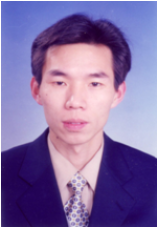
Research Center of Basin and Reservoir
 Dr. Zhang Tonggang
Dr. Zhang Tonggang
Education
PhD from University of Quebec at Montreal(Canada)
PhD from Institute of Geology and Geophysics,
Chinese Academy of Sciences
Master from China University of Petroleum-Beijing
Bachelor from China University of Petroleum-Huadong
Research
Stable isotopic geochemistry
Biogeochemistry
Sedimentology
My research interests focus on the environmental influences on major biological events, especially the mass extinction and the biodiversification. .
Teaching
The Research project of geochemistry
Stable Isotope Geochemistry
Previous Teaching Experience
2003-2005, Institute of Geology and Geophysics, Chinese Academy of Sciences
Professional Affiliations
Membership of European Associatio?n of Geochemist?ry
Contact
Email: zhang.tonggang@cup.edu.cn
TEL: +86-010- 89733422
Address of Office: No.18 Fuxue Road, Changping Dist., Beijing102249, China
Geosciences College, China University of Petroleum-Beijing
Publications:
1.Zhang T., Trela W., Jiang S., Nielsen J.,Shen Y., 2011. A major oceanic redox condition change correlated with the rebound of marine animal diversity during the Late Ordovician. Geology 39(7), 675-678.
2. Shen Y., Farquhar J., Zhang H., Masterson A., Zhang T., Wing B., 2011. Multiple S-isotopic evidence for episodic shoaling of anoxic water onto the shelf during the Latest Permian mass extinction. Nature Communications 2:210doi: 10.1038/ncomms1217 (2011).
3. Zhang T., Shen Y., Algeo T., 2010. High-resolution carbon isotopic records from the Ordovician of South China: Links to climatic cooling and the Great Ordovician Biodiversification Event (GOBE). Palaeogeography, Palaeoclimatology, Palaeoecology 289, 102-112.
4. Zhang T., Shen Y., Zhan R., Shen S., Chen X., 2009. Large perturbations of the carbon and sulfur cycle associated with the Late Ordovician mass extinctions in South China. Geology 37, 299-302.
5. Shen Y., Zhang T., Hoffman P.F., 2008. On the coevolution of Ediacaran oceans and animals. PNAS 105, 7376-7381.
6. Algeo T., Shen Y., Zhang T., Lyons T.W., Bates S., Rowe H., Thoa N.T.K., 2008. Association of 34S-depleted pyrite layers with negative carbonate 13C excursions at the Permian-Triassic boundary: Evidence for upwelling of sulfidic deep-ocean water masses. Geochemistry, Geophysics, Geosystems 9(4), doi:10.1029/2007GC001823
7. Chu X., Zhang T., Zhang Q., Lyons T. W., 2007. Sulfur and carbon isotope records from 1700 to 800 Ma carbonates of the Jixian section, northern China: Implications for secular isotope variations in Proterozoic seawater and relationships to global supercontinental events. Geochimica et Cosmochimica Acta 71, 4668–4692.
8. Shen Y., Zhang T., Chu X., 2005. C-isotopic stratification in a Neoproterozoic postglacial ocean. Precambrian Research137, 243–251.
9. Zhang T., Chu X., Zhang Q., Feng L., Huo W., 2003. The sulfur and carbon isotopic records in the carbonates of the Dengying Formation in the Yangtze Platform, China. Acta Petrologica Sinica 20(3), 717-724.
10. Zhang T., Chu X., Zhang Q., Feng L., Huo W., 2003. Variations of sulfur and carbon isotopes in seawater during the Doushantuo stage in late Neoproterozoic. Chinese Science Bulletin 48(13), 1375-1380.
12. Chu X., Zhang T., Zhang Q., Feng L., Zhang F., 2004. Carbon isotopic variations of Proterozoic carbonates in Jixian, Tianjin, China. Science in China (Ser. D)47(2), 160-170.
13. Chu X., Zhang Q., Zhang T., Feng L., 2003. Sulfur and carbon isotopic variations in Neoproterozoic sedimentary rocks from southern China. Progress in Nature Science13(11), 875-880.
14. Feng L., Chu X., ZhangQ., ZhangT., Li H., Jiang N., 2004. New evidence of deposition under cold climate for the Xieshuihe Formation of the Nanhua System in northwestern Hunan, China. Chinese Science Bulletin 49(13), 1420-1427.
15. Zhang Q., Chu X., Bahlburg H., Feng L.,Dobrzinski, N., Zhang Tonggang, 2003. Stratigraphic architecture of the Neoproterozoic glacial rocks in the “Xiang-Qian-Gui” region of the central Yangtze Block, South China. Progress in Nature Science 13(10), 783-787.



